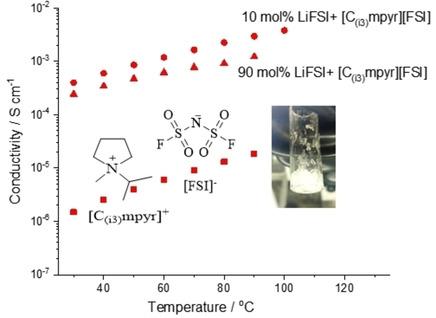当前位置:
X-MOL 学术
›
ChemElectroChem
›
论文详情
Our official English website, www.x-mol.net, welcomes your
feedback! (Note: you will need to create a separate account there.)
Designing Solid‐State Electrolytes through the Structural Modification of a High‐Performing Ionic Liquid
ChemElectroChem ( IF 3.5 ) Pub Date : 2020-09-10 , DOI: 10.1002/celc.202000772 Jennifer M. Pringle 1 , Danah Al-Masri 2 , Ruhamah Yunis 2 , Anthony F. Hollenkamp 3
ChemElectroChem ( IF 3.5 ) Pub Date : 2020-09-10 , DOI: 10.1002/celc.202000772 Jennifer M. Pringle 1 , Danah Al-Masri 2 , Ruhamah Yunis 2 , Anthony F. Hollenkamp 3
Affiliation

|
Solid‐state electrolytes can address many of the challenges associated with lithium metal batteries, as they can suppress the reactivity of the lithium metal and reduce the growth of dendrites, which is a main cause of device failure. However, achieving sufficient target ion transport through solid electrolytes remains a challenge. Here we report the structural modification of a high‐performing ionic liquid to form a quasi‐solid state electrolyte. Thus, the organic ionic plastic crystal N‐isopropyl‐N‐methylpyrrolidinium bis(fluorosulfonyl)imide, [C(i3)mpyr][FSI], has been synthesized and, when mixed with lithium salt, is shown to have a similar lithium‐ion transference number as the analogous [C3mpyr][FSI] ionic‐liquid‐based electrolyte. Furthermore, high ionic conductivity and efficient lithium cycling are demonstrated for two quasi‐solid‐state electrolytes, one with the very high lithium salt content of 90 mol % LiFSI.
中文翻译:

Designing Solid‐State Electrolytes through the Structural Modification of a High‐Performing Ionic Liquid
Solid‐state electrolytes can address many of the challenges associated with lithium metal batteries, as they can suppress the reactivity of the lithium metal and reduce the growth of dendrites, which is a main cause of device failure. However, achieving sufficient target ion transport through solid electrolytes remains a challenge. Here we report the structural modification of a high‐performing ionic liquid to form a quasi‐solid state electrolyte. Thus, the organic ionic plastic crystal N‐isopropyl‐N‐methylpyrrolidinium bis(fluorosulfonyl)imide, [C(i3)mpyr][FSI], has been synthesized and, when mixed with lithium salt, is shown to have a similar lithium‐ion transference number as the analogous [C3mpyr][FSI] ionic‐liquid‐based electrolyte. Furthermore, high ionic conductivity and efficient lithium cycling are demonstrated for two quasi‐solid‐state electrolytes, one with the very high lithium salt content of 90 mol % LiFSI.
更新日期:2020-10-15
中文翻译:

Designing Solid‐State Electrolytes through the Structural Modification of a High‐Performing Ionic Liquid
Solid‐state electrolytes can address many of the challenges associated with lithium metal batteries, as they can suppress the reactivity of the lithium metal and reduce the growth of dendrites, which is a main cause of device failure. However, achieving sufficient target ion transport through solid electrolytes remains a challenge. Here we report the structural modification of a high‐performing ionic liquid to form a quasi‐solid state electrolyte. Thus, the organic ionic plastic crystal N‐isopropyl‐N‐methylpyrrolidinium bis(fluorosulfonyl)imide, [C(i3)mpyr][FSI], has been synthesized and, when mixed with lithium salt, is shown to have a similar lithium‐ion transference number as the analogous [C3mpyr][FSI] ionic‐liquid‐based electrolyte. Furthermore, high ionic conductivity and efficient lithium cycling are demonstrated for two quasi‐solid‐state electrolytes, one with the very high lithium salt content of 90 mol % LiFSI.











































 京公网安备 11010802027423号
京公网安备 11010802027423号